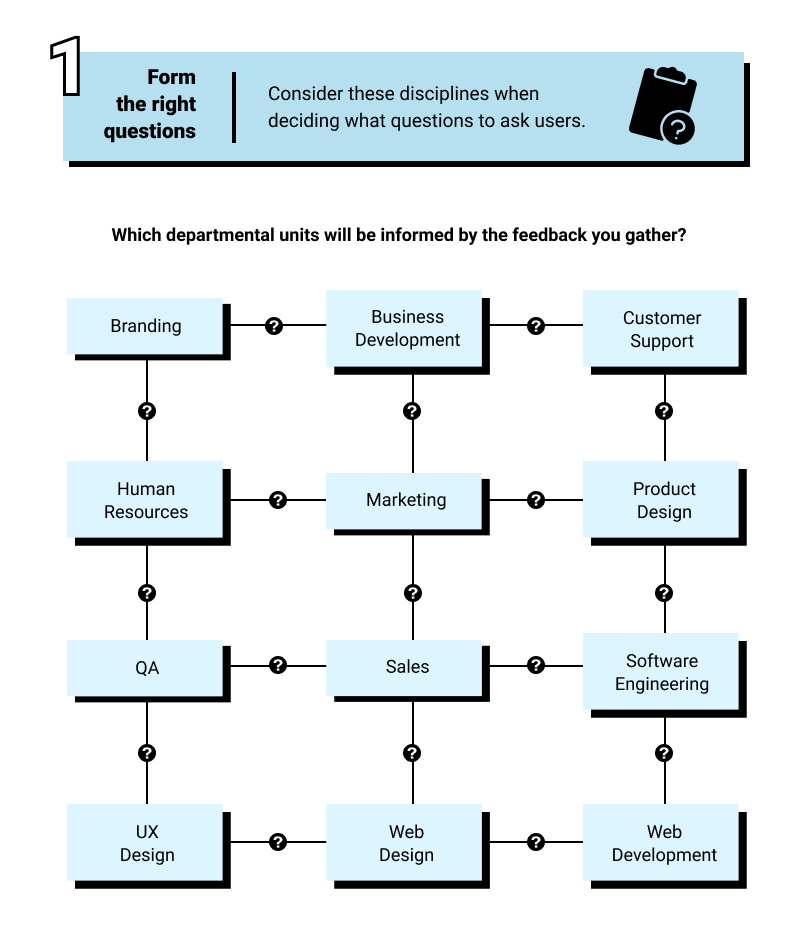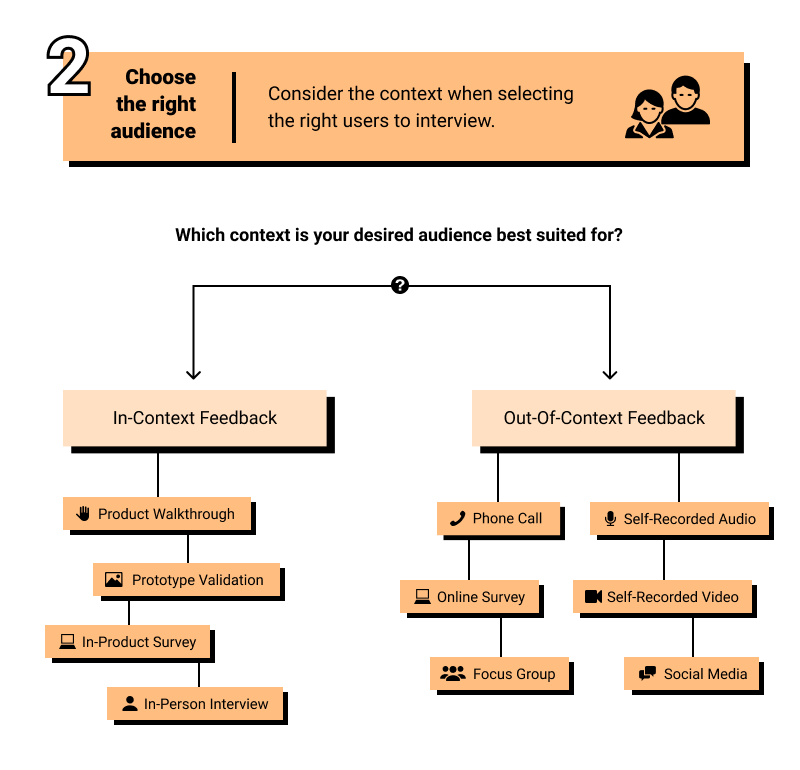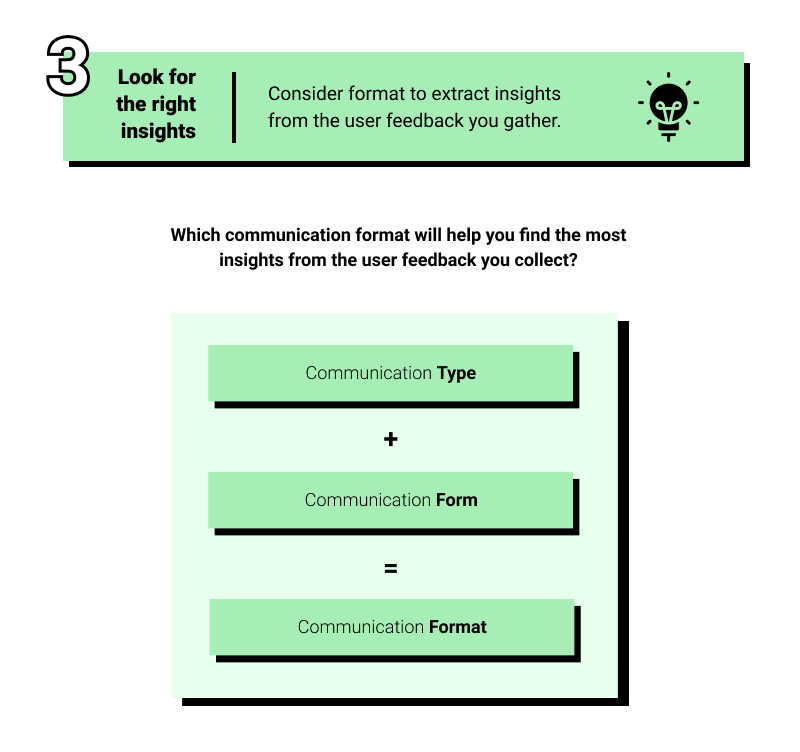
Get Better User Feedback by Considering These Three Things
When gathered thoughtfully, user feedback can serve as an important foundation for human-centered and data-driven design. Yet out of the many research methods commonly found in professional contexts, user feedback is arguably fraught with more trade-offs than most.
Without the right guidance, and lacking a clear research direction, user feedback can cause organizations to waste resources for comparatively few results.
Given its open-endedness, it can be difficult to get the most out of user feedback not just when collecting it, but also when analyzing and reporting it. This is because it can be difficult to form the right questions, to choose the right audience, and to look for the right insights when planning feedback gathering activities. Yet none of these potential pitfalls detract from the immense value that this feedback can provide about the state of your product, service, brand, or organization.

At its best, user feedback takes the guesswork out of business, marketing and creative strategy by leveraging a data-driven approach that helps illuminate user needs with qualitative factors. It provides a way for organizations to interface internal and external concerns in a way that brings them into closer alignment with the user. Such an endeavor is as much about choosing the right research practices as it is about strong communication practices.
It may sound intimidating to hear a phrase like ‘research practices’ if the scope of your user feedback project involves something as simple as sending out a short online survey.
However, no matter the size of your user feedback project, it pays to apply a solid conceptual structure to the types of questions you ask. Doing so can ensure that you maximize the value your organization gets out of gathering user feedback.
A Step-by-Step Guide to Gathering Great User Feedback
There are many factors that affect how user feedback can be used to best suit your project needs. Discipline, context, and format are three of the main driving factors that can affect the quality and usefulness of the feedback you gather. Some of the common pitfalls associated with gathering user feedback can be avoided by defining and differentiating these three factors at the start of a project.
Step 1: Form the Right Questions by Considering Discipline
Discipline refers to the specialized field for which the user feedback is being gathered. There are many disciplines for which you might want to gather user feedback including UX, web design, product design, web development, branding, marketing, sales, business development, human resources, and QA – to name a few. More often than not, these disciplines will overlap and inform each other, becoming an interdisciplinary network that facilitates holistic communication and research.
The motivations driving each of these disciplines can vary considerably, even if the questions they’re asking seem identical. Clarifying the disciplines involved in a project can ensure feedback objectives don’t become convoluted. In some cases different disciplines might have overlapping priorities, but that isn’t always the case – this is where some clarification upfront can help.

Some questions that can help clarify disciplinary motivations and interrelations include:
- Why are we gathering this feedback – what events (if any) precipitated the need for this project?
- Which departments or disciplines can this user feedback inform?
- Which departments or disciplines will this user feedback inform?
- Which departments or disciplines, if any, should this user feedback not inform?
Step 2: Choose the Right Audience by Considering Context
Context refers to the situational considerations that can affect the quality of the feedback you gather. In some cases it can be more useful to gather feedback in-context, as is the case when users provide feedback while using a website in the moment, or while testing a product at an event. There are many advantages to gathering in-context feedback because it reduces the cognitive distance between the user and the thing you’re gathering feedback about.
However, there are also some challenges that come with gathering feedback in-context, especially logistically speaking. For example, it can be difficult to figure out the best way to collect feedback as if the user is in their typical environment. In some cases, you might want to record user actions on their phone screen while also using the phone’s camera to record their faces. In other cases you might want to do a full-body recording of a user to capture their body language and environmental interactions.

It’s important to understand a user’s level of technological proficiency in comparison to the context within which you want to interview them. In-context feedback gathering can require a higher level of involvement than out-of-context feedback gathering might necessitate. Finding users who feel comfortable being interviewed in scenarios that may require more technological know-how can ensure the time it takes to gather their feedback is well-spent.
In-Context Advantages:
- Lets you observe and evaluate user behavior in controlled scenarios
- Reduces distance between user and the scenario they’re providing feedback about
In-Context Disadvantages:
- It can be difficult to recreate a scenario to test
- Technical difficulties can hamper the effectiveness and quality of feedback, or at least shorten the time you have to conduct the interview
In other cases, it’s simply more practical to gather feedback out-of-context. In a best case scenario, you have focus groups, where you have more control over environmental factors, and are encouraging the interviewees to focus solely on the interviewer. In a worst case scenario, you have an online survey, where you have no control over environmental factors, and can’t be sure how much of the user’s attention will be directed at your survey. Phone and video interviews reside somewhere in between those two extremes.
The challenges with gathering user feedback out-of-context are inherent in the wide spectrum of responses possible – wider than the spectrum of results possible when gathering feedback in-context. The margin of error can be a lot higher with feedback gathered out-of-context because the conceptual boundaries are usually more ambiguous, or at least less stringently imposed during the out-of-context interview process.
Out-of-Context Advantages:
- Focuses user attention on the interviewee depending on the scenario
- Encourages interpretation of visual and aural cues depending on the scenario
Out-of-Context Disadvantages:
- User is removed from the scenario they’re being asked about
- Wide margin of error in terms of the relevance and usefulness of the feedback you gather
For this reason, knowing who your audience is and knowing what their technological preferences are can ensure you choose the right context in which to interview them. Regardless of which you end up choosing, acknowledging the context in which feedback is gathered can go a long way towards increasing its effectiveness and reducing misunderstandings.
Step 3: Look for the Right Insights by Considering Format
Format refers to the type and form of communication that your feedback activity takes. To begin with, it’s important to remember that not all user feedback comes in the form of words. Unspoken and/or non-verbal behavior can be just as informative depending on the types of insights your project can be informed by.
Popular types of feedback gathering activities include user interviews, user surveys, focus groups, embedded chats, self-report diaries, etc. Those activities can come in a variety of communication forms including writing, in-person conversation, audio recordings, video recordings, photographs, numerical data, etc. When combined, the type and form of a communication activity can collectively be viewed as its format.
The format in which you gather user feedback can determine the amount of resources it takes to extract insights from it. For example, written feedback lends itself to language analysis more easily than a video or audio recording might.
However, if your project goals don’t benefit from language analysis as much as they’d benefit from facial expression tracking, then you might be better off going with the communication format that supports those project goals instead. Considering format in this way can ensure you extract the best possible insights from the feedback you gather.

Popular types of communication for gathering feedback:
- User interviews
- User surveys
- Focus groups
- Embedded chats
- Self-report diaries
Popular forms of communication for gathering feedback:
- Writing
- In-person conversation
- Phone conversation
- Video conversation
- Audio recordings
- Video recordings
- Photographs
- Numerical data
Format is usually the thing people remember last (if at all) when coming up with ways to gather user feedback, because it’s usually taken for granted.
However, communication format is what determines whether the feedback you collect contains non-verbal data like tone of voice, body language, facial expression, and even language cadence.
In some user feedback projects those additional communication cues might be unnecessary, but in other cases they can provide valuable information about an interviewee’s emotional and subconscious responses in the moment – information that isn’t as readily communicated with certain communication formats.
Conclusion
Collecting user feedback is ultimately an exercise in forming a human connection with the user so you can better understand and meet his or her needs. It’s also an opportunity to signal to users that you actively care about what they think. More importantly, gathering user feedback can greatly reduce the time it takes to iteratively improve your products or services.
By using discipline, context and format to inform the way you form questions, choose your audience, and look for insights, you can ensure that the business and creative decisions you make are informed by more than just conjecture. While this three-step guide is by no means comprehensive, it highlights fundamental considerations that seem to often get overlooked in online discussions about user feedback.